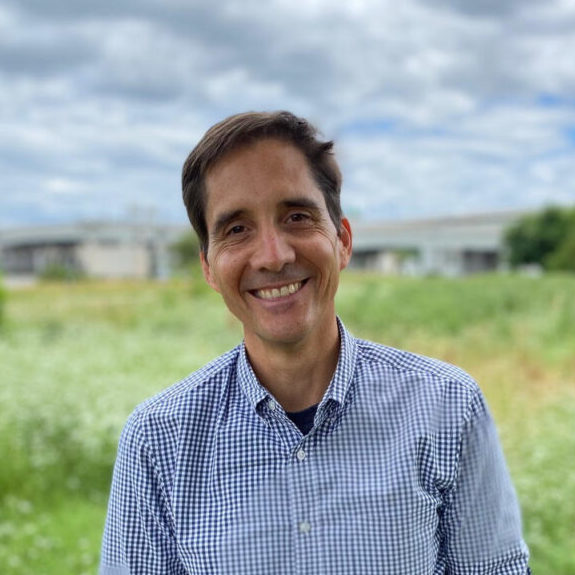Virtual Seminars are engaging and interactive learning opportunities for small groups of mayors and their senior staff. Each one-hour seminar features a deep-dive presentation on a single timely topic from a design expert, followed by a moderated group discussion among the attendees.
Designing for Health Equity: The 11th Street Bridge Park
This seminar, recorded August 2, 2023, explored how the 11th Street Bridge Park in Washington, DC – breaking ground later this year – will reconnect the surrounding communities and bring a transformation to the Anacostia River. Scott Kratz (Senior Vice President, Building Bridges Across the River) shared equitable development strategies honed over years of community engagement, and discussed how infrastructure reuse projects can promote community health and wellness.
Watch the presentation (24:04):
Key Takeaways
Using infrastructure to address health disparities
For generations, the Anacostia River has physically isolated the neighborhoods to its east from the rest of Washington, DC. The divide has exacerbated economic and social disparities that have resulted in greater rates of obesity, asthma, and diabetes, food insecurity, and lack of safety compared to other parts of the city.
The 11th Street Bridge spanning the Anacostia River has reached the end of its lifespan, but rather than demolishing the infrastructure, the city chose to extend the life of this investment by turning the aged-out freeway into a public amenity, reconnecting long-divided communities. Partnering with nonprofit Building Bridges Across the River ensured that the project was a community-led endeavor. There is often a large trust deficit between underserved communities and outsiders promising a better future, especially in communities of color. While there can be understandable skepticism at first, letting the community shape the process and outcome garners the trust and rapport critical for making positive change.
In co-designing the bridge’s transformation, the community drew up a robust list of amenities, including an intergenerational play area, a running track around the perimeter, a central gathering space, raised planting beds for urban agriculture, and an Environmental Education Center. To better integrate health equity into the project, leaders also looked at the social determinants of health and created new initiatives and programming to address them in tandem with the park’s planning: economic stability, education, social and community context, health and health care, and neighborhood and built environment.
By prioritizing measurable outcomes, project leaders were able to stay aligned with the goals and values established at the beginning of the process and demonstrate results and progress to continue motivating community engagement.
A model for equitable development
Building Bridges Across the River worked with the community, local non-profits, and community leaders to assemble an equitable development plan. They recognized a need for jobs, affordable housing, preservation of black-owned businesses, and arts and culture strategies — thinking not only about engaging the community on the project’s design, but how to ensure that the tens of thousands of residents offering input would benefit from it as well. They arrived at the following seven steps as a framework for establishing and implementing an equitable development plan:
- Step 1: Identify key stakeholders such as residents, municipal leaders, NGOs active in the area, civic associations, business owners, etc.
- Step 2: Establish your geographic area of impact and collect data
- Step 3: Engage stakeholders as part of the planning process and build ownership
- Step 4: Release the Equitable Development Plan
- Step 5: Begin implementing strategies
- Step 6: Ongoing evaluation
- Step 7: Celebrate early wins to build confidence
This framework has already been replicated in other cities across the country such as Buffalo, NY; Dallas, TX; Grand Rapids, MI; and San Francisco, CA. While anti-displacement strategies may look different in each place, the strategies for engaging local residents can be replicated regardless of location.
Resources
- 11th Street Bridge Park Equitable Development Plan
- Equity Tool Kit: 7-step process for creating your own equitable development plan
- Equitable Development and Urban Park Space: Year 4 Progress Report on Implementation of the Equitable Development Plan of the 11th Street Bridge Park
- High Line Network: The Network’s mission is to support a community of infrastructure reuse projects in creating vibrant and equitable public spaces.
Speaker

Scott Kratz
Senior Vice President, Building Bridges Across the River
Director, 11th Street Bridge Park
For the last ten years, Scott has been working with the East of the River based non-profit Building Bridges Across the River and the Washington DC city government to transform an old freeway bridge into a park above the Anacostia River. The old 11th Street Bridges that connect Capitol Hill with communities east of the river reached the end of their lifespan, Scott is working with the community to use the base of one of the bridges to create a one of a kind civic space supporting active recreation, environmental education and the arts. Scott leads the team that is designing, building and one day operating the park. Beyond the park’s physical construction, he has led the effort to ensure long term residents can stay and thrive in place through a nationally recognized equitable development plan that includes affordable housing, workforce training, preservation of Black owned small businesses and arts / culture strategies.

